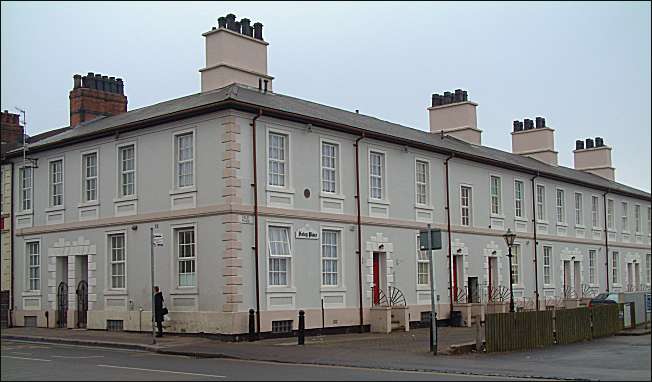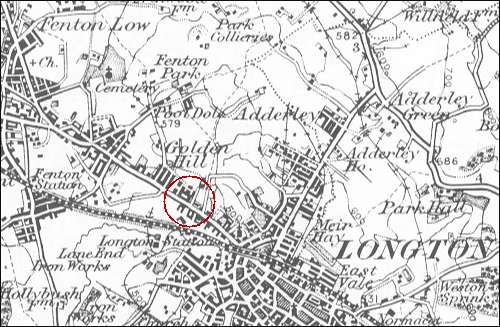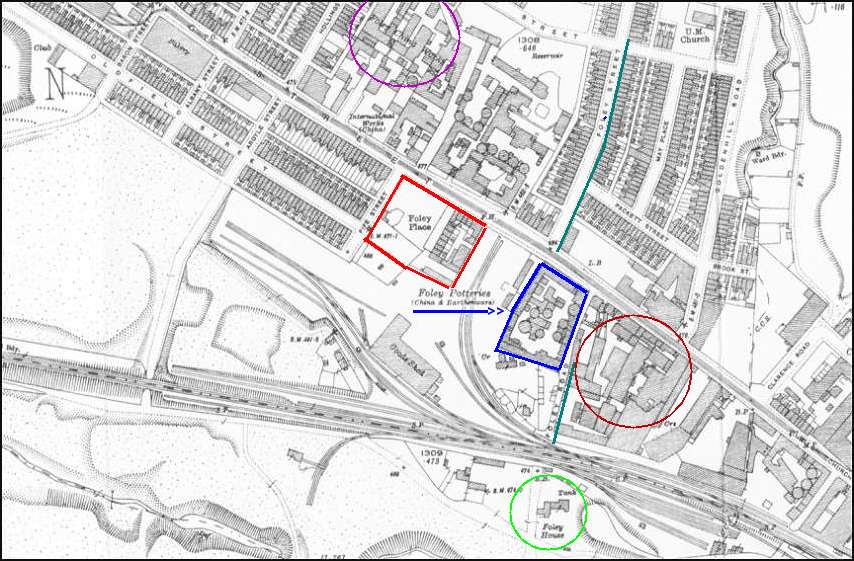|
The
Foley, Fenton,
Stoke-on-Trent, Staffordshire.
The area known as "The
Foley" is centred on King Street, near the Longton boundary. By the
1830's there were several potworks and some large houses.

Foley Place
(photo 2003)
Foley Place
Foley Place is near the east
end of King Street and was probably built in the 1830's or 1840's and is an
example of middle-class housing with some attempt at a formal layout,
rare in the Potteries at that date. It consists of an L-shaped block of
two-stories stucco houses with basements, late Georgian in style. There
were originally eleven houses and an inn, the 'Foley Arms,' while a
communal garden (now covered by a garage and petrol station) was laid
out to the west. [see map]
Foley House
Foley House, lying south of
the railway line and just west of the boundary with Longton, still
existed as a farm in the early 1950's.
Dominican nuns
Early in 1851 a small
community of Dominican nuns under Mother Margaret Hallahan opened a
convent at the Foley. On the the expiry of the lease in 1854 the convent
was moved to Stoke. (Our Lady of the Angels, Stoke).
Pottery history
About 1750 John Barker, one
of Thomas Whieldon's ovenmen in 1749, began to make shining black ware
and salt-glazed stone-ware at the Row Houses near the Foley. He worked
in partnership with this brothers and with Robert Garner, who had been
one of Whieldon's apprentices. He later he also made cream-coloured
ware.
At the end of the 1700's
Richard Astbury (John Astbury's grandson), was recorded as a potter at
the Foley.
Wesley's preaching at
Foley...
|
Extract
from John Wesley's journal:
"1790, Sunday, March 28th - I preached soon after one,
in Mr. Myatt's yard at Lane End; the house would not contain a quarter
of the people. At Burslem, also, I was obliged to preach abroad; such
were the multitudes of the people.'
"This is the last entry in reference to the labours of this venerable
divine, in the potteries. He was then in his 88th year, and
died within a few months afterwards."
 on Wesley & the
Potteries
on Wesley & the
Potteries |
Foley in
the history books....
Foley - 1829
"The FOLEY has only a few
houses, and three Manufactories in it. The Manufactory of Messrs. Elkin,
Knight, & Bridgwood, is a new and very complete establishment; having in
addition to the customary buildings a powerful Steam Engine and Flint
Mill. The productions of this establishment are very superior in their
quality, and have obtained celebrity in the markets. The proprietors are
gentlemen of the most respectable character as tradesmen and members of
civil society.
Opposite are the house and Manufactory of C. Bourne, Esq., the former
the best on this side, for excellence of construction, and the elegance
of appearance. Connected with it are spacious Gardens; and contiguous is
the manufactory.
At the southern extremity are the House and Factory of the late Mr.
Myatt; one of the first persons who received the Wesleyan Methodist
Preachers; and in whose parlour the late Rev. J. Wesley stood, while
from the window he preached to a vast congregation, when last he passed
thro' Staffordshire only a few months prior to his decease."
"History of the
Staffordshire Potteries", Simeon Shaw.1829
Foley -
1843
"The FOLEY
is the farthest portion of the three-fold division we make of the
Fentons, and is situate wholly in Fenton-Culvert; whether the name was
derived from the Lords Foley, former proprietors of the adjoining manor
of Longton, or was a sarcasm on some person's taste in architecture, we
are ignorant.
Here are two extensive manufactories: viz., the modern and
very complete works held by the firm of KNIGHT, ELKIN, and BRIDGWOOD,
for china and earthenware, erected a few years since, by the late John
Smith Esq., combining a steam-engine, a flint mill, and every other
convenient adaptation to the business - also the manufactory, with and
excellent house attached, erected by the elder Josiah Spode, for his
second son, Mr. Samuel Spode.
These have since been occupied by various tennants, and were last held by Mr. Charles Bourne, but are, whilst we
write, unoccupied.
Adjacent thereto is a manufactory occupied by R. Gallimore, formerly
belonging to Mr. Joseph Myatt, from the front of the house adjoining
which the late rev. John Wesley preached on his last journey to a large
to a large auditory as mentioned in his journal."
"The Borough of Stoke-upon-Trent ", John Ward.
1843
Mother Margaret Hallahan
(orphaned at the age of seven, earning her own living as a
housemaid in her childhood years) was the foundress of the
English Congregation of Nuns of the Third Order of St.
Dominic, who have convents and hospitals at Stoke on Trent
and Stone. The latter is the burying place both of
Archbishop Ullathorne and Mother Margaret.
Mother Margaret Hallahan is one of the Catholic patron
saints of the gravely ill.
>>back to
place |
 |
![]()
![]() 1895 map showing location of Foley
1895 map showing location of Foley![]() 1922 map showing Foley in detail
1922 map showing Foley in detail

![]()